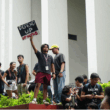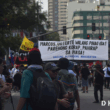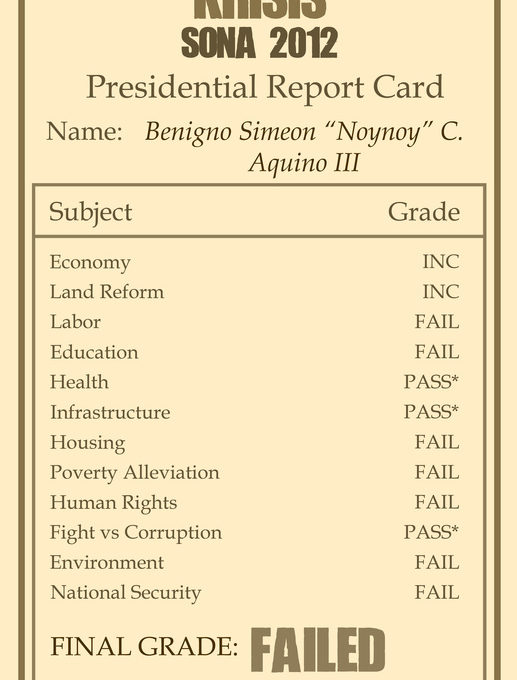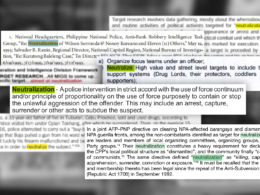More than two years after assuming office, Pres. Benigno Simeon ‘Noynoy’ Aquino will be delivering his third State of the Nation Address (SONA) in the Batasang Pambansa today.
Mainstream media has been abuzz in the days running up to this year’s SONA, with reports indicating that PNoy – as the president has branded himself – will drum up his administration’s achievements in the economic front, as well as in the fight against government graft and corruption.
Critics, meanwhile, have also aired their own take on the true state of the country, highlighting the Aquino government’s sluggish action on human rights violations, among other issues.
Based on reports on the past two SONAs and the administration’s actions in the run-up to SONA 2012, KRISIS has assembled a Report Card on PNoy’s performance in the nation’s most critical sectors.
Read on for an in-depth assessment of the government programs and promises that have been implemented and created last year.
THE ECONOMY
KRISIS GRADE: INC
In the first quarter of 2012, the country’s Gross Domestic Product (GDP) rose by 6.4% – the best economic performance recorded under PNoy’s watch so far. This adds to a slew of macroeconomic indicators pointing to a seemingly healthy economy: inflation is at a minimum, our currency and stock market are among the best-performing in the region and the world, export numbers are up this month compared to the same period last year, and international trade experts hint that the Philippines may well survive a Eurozone collapse and weather the on-going global economic crisis better than most other nations.
However, macroeconomic strength has not translated into bottomline prosperity for most Filipinos. In fact, the gulf between the extremely rich and the extremely poor has further widened this year. Forbes Magazine lists 15 Filipino billionaires, up from 11 last year. The Philippines’ 40 richest people now have a combined wealth of $47.4B, up by $13B from last year. Meanwhile, according to IBON’s 2012 Midyear Birdtalk, the wealth of the country’s 25 richest ($21.4B) is equivalent to that of the poorest 11.1M Filipinos.
Although efforts to bring in foreign direct investments (FDIs) and the prospect of an economic slowdown in China have contributed to a slight increase in FDI numbers, economic analysts still point to a sluggish investment climate in the country. Factors like government transparency and accountability ease of doing business, and high energy costs (PH power rates are the highest in Asia) negate the positive effects of the credit rating upgrades given to the country this year by investment agencies Fitch Ratings and Standard and Poor’s.
Despite its outward strengths, the economy is still largely reliant on foreign remittances, as well as the export of raw materials and light manufactured goods.
LAND REFORM
KRISIS GRADE: INC
Earlier this year, the farmers of Hacienda Luisita finally won their fight for the distribution of the Conjuanco-run agricultural estate, although the actual distribution of lands has yet to commence. The Aquino government followed this up with renewed engagement with farmers’ rights groups regarding the implementation of the Comprehensive Agrarian Reform Program – Extended with Reforms (CARPER).
The president has promised to distribute all properties subject to CARPER by 2014, although Congress will not push for another extension of the two-decade-old land reform program, and despite the government failing to distribute almost half of targeted lands under the Land Acquisition and Distribution Plan 2011. It distributed an average of 9,324 hectares in 2011 and at the current rate, is five years behind schedule with its June 2014 target.
Even with the Aquino government’s renewed interest in agrarian reform, bones of contention still exist between the administration and farmers’ groups. For one, there are the much-criticized non-land transfer schemes provided for by CARPER. These include the Stock Distribution Option (SDO; dropped by the Supreme Court in favor of land distribution in a landmark decision earlier this year), and corporate joint ventures.
There is also an aversion of the Liberal Party-dominated Congress to the Genuine Agrarian Reform Bill being pushed by the Makabayan Coalition, which stipulates all-out land distribution, and which militant farmers’ groups say has a better land reform framework than the current CARPER.
LABOR
KRISIS GRADE: FAIL
This year is not the year for workers who have been demanding a P125.00 across-the-board wage increase nationwide. In his Labor Day speech delivered to members of Cabinet and representatives of workers’ groups in Malacanang last May, the president shot down workers’ long-standing demands for a pay raise, justifying the move by saying that a wage increase will cripple the economy, kill small- and medium-sized enterprises (SMEs), and result in business-sector cost-cutting and massive layoffs.
Instead of a wage increase, PNoy left the Regional Tripartite Wage and Productivity Boards to decide on wage increases in their localities. As a consolation, the president pushed for a P30.00 raise in workers’ Cost of Living Allowance (COLA). This, despite the latest survey by the International Labor Organization indicating that Filipino workers receive the third lowest wages in the world.
Workers in the National Capital and Southern Tagalog Regions – the most industrialized areas of the country – have been further subjected to large-scale contractualization (as was the case in the PALEA labor dispute last year) by virtue of the Labor Department Order 18-A Series of 2012, which allows companies to contractualize and even sub-contractualize labor and cut their personnel costs in the process.
There is also the implementation of the two-tiered wage system (2TWS) in factories across Mega Manila. Under the 2TWS, the government shall dictate a floor wage, or base wage, similar to how regional wage boards dictate provincial wages. A second wage level – a productivity wage – will be determined by companies based on their production rates. Workers’ groups such as the Kilusang Mayo Uno (KMU) have lambasted these government-led labor initiatives, saying that these policies further mire Filipino workers in deepening poverty.
Last month, government workers received the fourth instalment of their salary hikes under the Salary Standardization Law III. However, members of Congress allied with the president are pushing for the privatization of the National Food Authority, as well as the formation of a Department of Housing, Planning and Urban Development that will merge several government agencies – moves that employees’ associations fear will result in government layoffs. So far, there is still no progress on the P6,000.00 salary increase being put forward by government employees’ associations.
Overseas Filipino workers (OFWs), on the other hand, face similarly daunting challenges under Aquino’s watch. Compounding a virtual freeze in labor demand across the globe as a result of the Great Recession happening in Western economies, civil strife in the Middle East and a flare-up in tensions in the Korean Peninsula early this year have brought on fears of massive OFW repatriation this year. In particular, tens of thousands of OFWs in Syria, Yemen and Egypt are still waiting for real government action regarding their plight.
EDUCATION
KRISIS GRADE: FAIL
The education sector has consistently received among the highest budget allocations in the 2011 and 2012 National Expenditure Programs. This year, the Aquino government is spending P238.8B for basic education, currently implementing the K+12 program. This is short of about P300B to equal the UN-recommended budgetary allocation of 6% of the country’s Gross Domestic Product, and only translates to spending P7 per student per day. This budget is also short by P70B to address shortages. According to the Alliance of Concerned Teachers, there will be a shortage of 132,483 teachers, 97,685 classrooms, 865,000 chairs, and 153,709 water and sanitation facilities this year.
Student groups on both sides of the political spectrum agree in contesting the K-12 program. According to the Student Council Association of the Philippines, K-12, which adds two more years to the basic education curricula in schools, does not suffice as an education platform. As for the League of Filipino Students, Anakbayan and other militant student groups, the additional burden the new basic education program puts on poor families and the rushed manner in which K+12 is being implemented delegitimizes its positive aspects.
Tertiary education has also taken major hits in Aquino’s term so far, with the Commission on Higher Education giving the go-ahead for tuition hikes in 222 private universities and colleges across the country during last month’s enrolment period. State Universities and Colleges (SUCs) have not been spared the fate of their private counterparts, with dozens of regional SUCs and even nationally important state universities like the University of the Philippines and the Polytechnic University of the Philippines implementing or planning to implement tuition and other fee increases. This year’s SUC budget of P26.1B is approximately P7B short of the amount required by SUCs to operate without charging their students higher fees.
HEALTH
KRISIS GRADE: PASS, but…
The government will spend almost P43B this year on healthcare, up from P32.427B last year. This budget, however, will be focused on increasing the salaries of health workers across the country, and maintaining operation costs in the nation’s hospitals.
This is also P47B short of the healthcare budget campaigned for by groups in the health sector. There is no budgetary allocation for the construction of new hospitals. A significant chunk of the budget – P12.5B – will benefit the Philippine Health Insurance Corporation (PhilHealth), while P3B will be spent on health-sector Public-Private Partnerships in 25 regional hospitals.
Last year, the Alliance of Health Workers had called for a P90B healthcare budget, citing the amount as the minimum requirement of the public healthcare sector to meet the immediate needs of poor Filipino patients. This minimum budget, in fact, is merely 22.5% of the UN-recommended P400B budget for healthcare, representing 5% of the country’s GDP.
PhilHealth benefits are also insufficient, and patients will still keep paying large sums from their own pockets. In 2008, PhilHealth covered some 40% of families yet only 7% of total health spending in the country, leaving 58% of health expenses out-of-pocket. Out-of-pocket expenses will likely still be high even if coverage increases to the projected 80% of Filipinos. Just this month, the Department of Health had announced the phase-out of charity wards in public hospitals, putting the fate of indigent patients wholly in the hands of PhilHealth under its “No Balance, No Billing” policy.
Across the country, hospitals are charging even indigent patients with additional fees for services that were once rendered for free. The only upside in Aquino’s health agenda this year is the deployment of more than 25,000 registered nurses in the provinces as part of the government’s Registered Nurses for Health Enhancement and Local Service or RNHeals Program.
INFRASTRUCTURE
KRISIS GRADE: PASS, but…
The Public-Private Partnership Center has disclosed that it will be handling 8 major transport projects, 3 water and power projects, 2 health-sector projects, and 1 major agricultural project this year. Another 43 PPP projects are in the pipeline, including 15 projects to be implemented by the Department of Transportation and Communications, around nine by the Department of Public Works and Highways, eight by local government units and two each by the Department of Agriculture and the Metropolitan Waterworks and Sewerage System.
Investors, though, are bemoaning the slow implementation of these projects. Quoted in an Inquirer.net article, Derek Page, director for trade and investments of the British Embassy in Manila said that “there is an understandable element of frustration among big companies in the UK but they’re waiting patiently. We try to convince them that it takes time to invest in the Philippines.”
HOUSING
KRISIS GRADE: FAIL
Urban poor communities in the country’s three metropolitan areas – Manila, Cebu, and Davao – have felt a marked increase in demolition orders and notices of eviction under Aquino’s watch. Violent evictions and armed demolitions have happened in Paranaque, San Juan, Manila, Quezon City and Malabon in NCR, as well as in Davao down in Mindanao.
Urban poor advocates criticize the relocation policies of the Aquino government, with some relocation sites located in identified geohazard areas on one hand, and the privatization of government housing projects (through the PPP scheme) on the other hand.
According to independent economic think tank IBON Foundation, the total estimated housing backlog by 2013 is 3,551,431 housing units – of which half is in NCR (1,076,149 units, or 30%), CALABARZON (408,315 units, 11%) and Central Luzon (289,857 units, 8%) – which is estimated to reach 5,732,454 by 2016. Yet according to the latest Philippine Development Plan (PDP) the government’s housing target is only 1,377,612 units as of 2013 or just 39% of the backlog.
POVERTY ALLEVIATION
KRISIS GRADE: FAIL
The Aquino government has reported that over one million jobs had been created in the first quarter of 2012, while the number of full-time workers actually fell by 1.6 million. This was only compensated for by a much larger 2.5 million increase in the number of part-time workers, who work for low wages and with little or no benefits. Part-time work now accounts for over 4 out of 10 (43%) jobs in the economy or 16.2 million out of 37.8 million employed.
Rampant unemployment and underemployment are still major stumbling blocks for Aquino’s poverty alleviation agenda. According to IBON estimates on National Statistics Office (NSO) data, the unemployed and underemployed comprised 27.7% (11.5 million) of the labor force in 2011 which is marginally higher than the 27.6% (11.2 million) in 2010.
The government’s flagship anti-poverty conditional cash transfer (CCT) program, the Pantawid Pamilyang Pilipino Program (4Ps), is a massive dole-out scheme that alleviates poverty only partially and temporarily. The CCT/4Ps program peaks in 2013/2014 with 3.7-4 million beneficiaries and graduates its last 350,000 beneficiaries in 2018. The first batch of some two million beneficiaries will graduate from the program next year and the program’s effects on these families’ jobs and incomes have yet to be seen, especially in an economy with a severe job crisis.
At the same time, the NSO has reported some 5.5 million child workers between the ages of 5 and 17 in 2011 – equivalent to almost one out of every five (19%) children aged 5-17 years – of whom 3 million work in hazardous environments.
HUMAN RIGHTS
KRISIS GRADE: FAIL
In the two years of the Aquino administration, human rights watchdog Karapatan has documented ninety-nine victims of extrajudicial killings; ten victims of enforced disappearances; threats, harassment, and intimidation and forced evacuation of whole communities; cases of torture, rape, illegal arrests and detention, most are results of military combat operations being waged especially in the rural areas. This comes alongside the serious cases of rights violations brought about by militarization of organized communities especially in the Bondoc Peninsula; the violent demolitions of urban poor communities such as in Silverio, Paranaque, where guns were trained and fired at the barricading residents; and police and military intimidation of militant sectoral groups.
To date, Karapatan has also documented the illegal arrest and detention of 107 individuals due to trumped up criminal charges, bring the total number of political prisoners to 385. The illegal arrest of consultants of the National Democratic Front continues with the arrest of trade union leader Reynante Gamara, while consultants Tirso Alcantara and Alan Jazmines are being subjected to inhumane and repressive conditions in jail.
This flies in the face of the Aquino government’s assertions that the country has no unresolved cases of human rights violations. In fact, there has been virtually no progress this year in the Maguindanao Massacre trial, and known human rights violators in the military like Gen. Jovito Palparan have yet to be arrested.
FIGHT AGAINST CORRUPTION
KRISIS GRADE: PASS, but…
The impeachment of Supreme Court Chief Justice Renato Corona last month may well be PNoy’s greatest victory in his war on graft and corruption this year. So far, the names of corrupt bigwigs brought to justice under Aquino’s watch include former Ombudsman Merceditas Gutierrez and former AFP Comptroller Jacinto Ligot and his wife Erlinda.
PNoy’s efforts against deep-seated corruption in the public and private sectors has earned praise from analysts both here and abroad, and the president has rightly capitalized on the anti-corruption fight’s confidence-boosting effect on people and businesses during his previous two SONAs.
However, a lot of big fishes still roam free. Charges have been filed against former president Gloria Macapagal-Arroyo, but trials have yet to be scheduled.
Although the Bureau of Internal Revenue and the Department of Finance are doubling their efforts in rooting out big-time tax evaders, the Customs Bureau still has to fully address the country’s smuggling problem.
Finally, there is the wider and more pervasive problem of corruption in the police, the armed forces, and the government rank-and-file – cases of which are more prevalent in the country’s Local Government Units (LGUs).
ENVIRONMENT
KRISIS GRADE: FAIL
The deaths of nearly two thousand people in Northern Mindanao as a result of the catastrophic floods there late last year is a testament to the level of environmental degradation currently happening in the country. The Aquino government has put disaster preparedness at the top of its environmental agenda, with spending in different government agencies earmarked for disaster mitigation.
However, steps to address environmental issues have been more reactionary than pre-emptive. This year, PNoy has signed 3 environment-related Executive Orders. Two of which – EO 23, declaring a nationwide logging ban, and EO 26, implementing a National Greening Program – came in the heels of the disaster in Northern Mindanao.
The latest environmental EO from Malacanang is EO 79, outlining the Aquino government’s mining policy. Even as EO 79 expanded the number of no-mining areas in the country, environmental activists argue that the executive order does not address the effects of industrial mining on agricultural lands and water systems.
Environmental groups Greenpeace Philippines and Kalikasan-People’s Network for the Environment (PNE) have criticized the log ban for having too many loopholes, including a section permitting the cutting of trees for agro-industrial purposes.
Both groups question PNoy’s commitment to diversifying the country’s energy mix. The Aquino government is actively pursuing the development of new coal-fired powered plants to address the energy needs of Visayas and Mindanao. Elsewhere in the country, there have been no new renewable energy projects.
Kalikasan-PNE has also raised concerns over the spate of killings among environmental workers and activists in the two years that Aquino has been in office. The group reports 7 environmental advocates, including broadcaster Dr. Gerry Ortega and world-renowned botanist and UP scientist Dr. Leonard Co, that have been killed during Aquino’s watch.
NATIONAL SECURITY
KRISIS GRADE: FAIL
The Philippines has yet to achieve a Minimum Defense Posture in relation to the archipelagic nature of the country’s territory, as well as the burgeoning military capability of China.
This year, the Aquino government has engaged in close talks with Washington D.C. to discuss defense issues and strengthen military ties through the expansion of the Visiting Forces Agreement, as well as enhancing the Balikatan US-PH Joint Military Exercises to increase interoperability between the two armed forces.
In the domestic front, PNoy has introduced a “new” Internal Peace and Security Plan nicknamed Oplan Bayanihan, which promises to involve the masses in the government’s counter-insurgency program. These developments, far from providing greater security for the country, seem to have jeopardized the security of the Filipino people even more.
The standoff between the Philippines and China in the disputed waters of the South China Sea have further deteriorated, with China resorting to fortifying its naval positions in Scarborough Shoal and areas of the Spratlys Islands, forcing the Philippines to beg for military assistance from the US. For its part, the US has kept its hands off the territorial dispute, although it has given the Aquino government military aid in the form of aging naval and air assets.
In the domestic counter-insurgency programs, critics have argued that Oplan Bayanihan has resulted in military-instigated human rights violations and rampant militarization of perceived insurgency hotspots across the country.
Peace talks have produced mixed results, with the Moro Islamic Liberation Front (MILF) agreeing to resume negotiations with the government, while the Communist Party of the Philippines-New People’s Army-National Democratic Front (CPP-NPA-NDF) has decided to postpone talks with the Aquino administration over the illegal detention of NDF consultants Tirso Alcantara and Alan Jazmines.
Law and order has not seen any improvement either, with a resurgent Abu Sayyaf holding hostage a Jordanian journalist on assignment in Mindanao. The Coast Guard is still unable to police the country’s porous maritime borders, while the Philippine National Police has seen no significant reduction in violent crime nationwide.
OVERALL GRADE: FAIL
PNoy has little to show for in terms of real progress in all the vital areas of national life in the past two years of his administration. Now entering his third year in office, analysts are hopeful that a P2 trillion proposed budget for 2013 – the highest in the nation’s history – will be a saving grace for the Aquino government. Department of Budget and Management Secretary Florencio “Butch” Abad says that next year’s budget revolves around the theme “Atas ng Bayan” – reflecting the government’s willingness to deliver the services that the Filipino people have been asking for.
2013 will be a high-stakes year for this administration, as it will serve as a referendum on the performance of his government. Challenges both foreign and domestic continue to confront PNoy’s administration. The Filipino people will have one more year to weigh Aquino’s commitment to reform and national progress.
This article was retrieved from a Wayback Machine archive of UPJC’s old website on July 13, 2024, 05:53:31 GMT.







